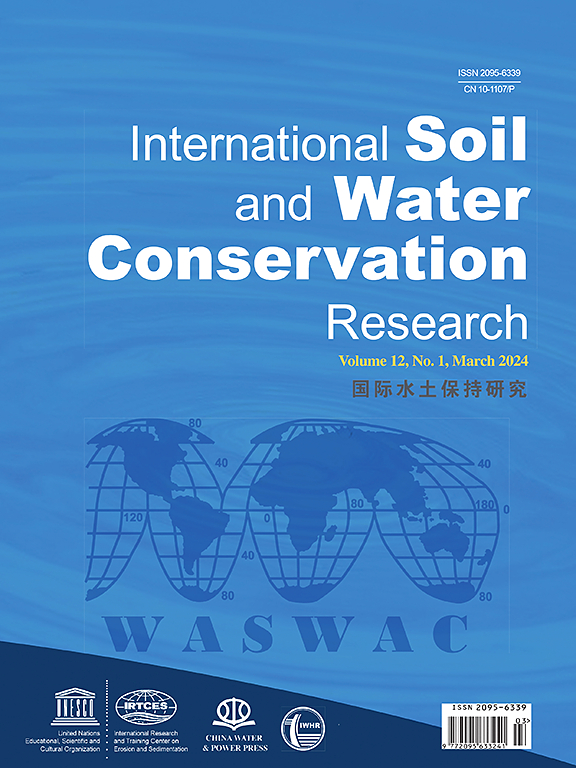中国软土春季融雪侵蚀对驱动因子响应的试验研究
IF 7.3
1区 农林科学
Q1 ENVIRONMENTAL SCIENCES
International Soil and Water Conservation Research
Pub Date : 2025-02-28
DOI:10.1016/j.iswcr.2025.02.008
引用次数: 0
摘要
融雪侵蚀是中国Mollisol地区春季土壤退化的主要过程,在全球变暖的背景下,融雪侵蚀进一步加剧。由于融雪期侵蚀过程复杂,受多种因素影响,融雪侵蚀机制尚不清楚。在本实验室研究中,我们考察了融化期间影响土壤侵蚀的三个关键因素:融雪流量(0.33 × 10−4、0.67 × 10−4和1.32 × 10−4 m2 s−1)、地下水文条件(渗漏和排水)和土壤融化深度(5和10 cm)。结果表明,渗流显著加重了产沙,产沙量比排水处理增加了50%。产沙量与融雪流量呈正相关,当流量从0.33 × 10−4 m2 s−1增加到0.67 × 10−4 m2 s−1时,由于径流能量和输沙能力的增强,产沙量增加了4倍以上。通径分析证实,融雪流量和地下水文条件是融雪侵蚀的主导因子(分别解释路径系数0.917和0.308),土壤融化深度的影响相对较小(解释路径系数0.032)。土壤解冻深度对细沟形态演化有显著影响;浅融化深度时,细沟向侧壁水平侵蚀,深融化深度时,细沟垂直向下侵蚀。此外,径流能量消耗(ΔE)是表征部分解冻斜坡土壤侵蚀的合适指标,具有较高的决定系数(R2 >;0.70)。总体而言,本研究为全面了解融雪侵蚀动态提供了科学依据,为中国Mollisol地区制定更多缓解春季土壤侵蚀和维持区域生产力的策略提供了依据。本文章由计算机程序翻译,如有差异,请以英文原文为准。
An experimental study on the responses of spring snowmelt erosion to driving factors in a Chinese Mollisol soil
Snowmelt erosion, a major spring soil degradation process in the Mollisol region of China, is further exacerbated in the context of global warming. The mechanism of snowmelt erosion remains unclear due to the complex erosion process influenced by multiple factors during the melting period. In this laboratory study we examined the effects of three critical factors influencing soil erosion during thawing period: snowmelt flow rates (0.33 × 10−4, 0.67 × 10−4, and 1.32 × 10−4 m2 s−1), subsurface hydrologic conditions (seepage and drainage), and soil thaw depths (5 and 10 cm). The results indicated that seepage significantly aggravated sediment yield, with sediment yield increasing by 50% in comparison to the drainage treatments. Sediment yield was positively correlated with snowmelt flow rate, and as the flow rate increased from 0.33 × 10−4 to 0.67 × 10−4 m2 s−1, the sediment yield increased by more than 4 times, due to the enhanced runoff energy and sediment transport capacity. Path analysis confirmed that snowmelt flow rate and subsurface hydrologic condition were the dominant factors for snowmelt erosion (explaining 0.917 and 0.308 of the path coefficients, respectively) while the effects of soil thaw depth were relatively low (explaining 0.032 of the path coefficients). However, soil thaw depth had a substantial impact on rill morphology evolution; rills tended to erode horizontally toward the sidewalls at shallow thaw depths, and evolved vertically downward at deeper thaw depths. Additionally, runoff energy consumption (ΔE) was a suitable indicator for characterizing soil erosion on partially thawed slopes with a high Coefficient of Determination (R2 > 0.70). In general, this study provides a scientific basis for a comprehensive understanding of snowmelt erosion dynamics, allowing development of more strategies for mitigating soil erosion in the spring and sustaining regional productivity in the Mollisol region of China.
求助全文
通过发布文献求助,成功后即可免费获取论文全文。
去求助
来源期刊

International Soil and Water Conservation Research
Agricultural and Biological Sciences-Agronomy and Crop Science
CiteScore
12.00
自引率
3.10%
发文量
171
审稿时长
49 days
期刊介绍:
The International Soil and Water Conservation Research (ISWCR), the official journal of World Association of Soil and Water Conservation (WASWAC) http://www.waswac.org, is a multidisciplinary journal of soil and water conservation research, practice, policy, and perspectives. It aims to disseminate new knowledge and promote the practice of soil and water conservation.
The scope of International Soil and Water Conservation Research includes research, strategies, and technologies for prediction, prevention, and protection of soil and water resources. It deals with identification, characterization, and modeling; dynamic monitoring and evaluation; assessment and management of conservation practice and creation and implementation of quality standards.
Examples of appropriate topical areas include (but are not limited to):
• Conservation models, tools, and technologies
• Conservation agricultural
• Soil health resources, indicators, assessment, and management
• Land degradation
• Sustainable development
• Soil erosion and its control
• Soil erosion processes
• Water resources assessment and management
• Watershed management
• Soil erosion models
• Literature review on topics related soil and water conservation research
 求助内容:
求助内容: 应助结果提醒方式:
应助结果提醒方式:


